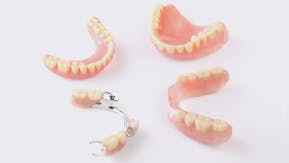The History and Evolution of Dentures
The history of creating dentures and replacement teeth goes back millennia, with the first records dating back to 3,500 years ago.2 Fortunately, the technology for making dentures is changing with the times! See how the history of dentures goes hand-in-hand with the history of dentistry itself.
How old is the practice of dentistry?
As early as 3,000 BCE, there were records of dentistry as a specialty in Egypt.3 This early culture is also believed to have constructed the first dentures, circa 2,500 BCE.3 During the medieval era, dentistry became the purview of specialized craftsmen ranging from wig makers to blacksmiths and bloodletters.1
By the time of the 18th century, naval surgeon Pierre Fauchard became known as the "father of modern dentistry,", due to his work in studying the gum health of sailors affected by scurvy.1 In an influential book on dentistry he published in 1728, he describes using ivory prosthetics (obturators) to fix oral issues such as cleft palate as well as missing teeth.1
Curiously, while the familiar toothbrush that we know today was originally popularized in 1770, toothpaste wasn’t invented until 1850, where American dentist Dr. Washington Wentworth Sheffield first placed it in tubes in 1878.1
Materials used for early dentures
Dentures have been made from materials that might seem strange to us today. Even the earliest versions of the Hebrew Talmud mention replacement teeth made of gold, silver, and wood.3 And during the 18th century the primary material of dentures included human teeth, animal teeth carved to the approximate size and shape of human teeth, ivory, and porcelain teeth.2
The development of porcelain was an especially skilled process, lifted from Chinese craftsmen in 1709.2 It replaced the use of human and animal teeth for certain advantages: it was less porous, didn’t absorb water as easily, and could be shaped to conform to underlying tissue.3 However, porcelain is a brittle material, and difficult to grind and polish.3
As dentists and surgeons developed aesthetic and hygienic concerns throughout the 18th and 19th centuries, materials evolved into tortoiseshell,3 cellulose nitrate (a type of plastic commonly known as celluloid),3 and even blends including carbon fiber.3 Acrylic dentures became popular because of their affordability and ease of fabrication compared to traditional techniques.4
If you’re familiar with American history, you may be asking yourself, “Did George Washington have wooden teeth?” One of the most popular legends about the founding father—aside from the cherry tree—is that George Washington had a set of wooden teeth. In fact, he had multiple sets: out of the four he had, he wore one made from hippopotamus ivory,2 and one made from wood.3
How dentures are made today
Acrylic dentures have served as a staple of oral hardware for decades, but the future of denture materials leans towards newer formulas more derived from natural biocompatible sources, such as zirconia.2
The advent of new technology such as computer-aided design and manufacturing (also known as CAD-CAM), as well as 3D printing, is transforming the way dentures are made.3 Dentists are now able to make dentures that are custom fit to each dental patient, increasing precision and comfort.3 This has made many different options available to fit your exact needs, such as flexible partial dentures, which can add to a patient’s quality of life.4
Remember to take proper care of your dentures with the latest formulations found in Polident denture cleansers and Super Poligrip denture adhesives.
Source Citations:
- Technology in Dentistry, Through the Ages. NYU Dentistry. https://dental.nyu.edu/aboutus/history/technology-in-dentistry-through-the-ages.html. Accessed 4/19/2024.
- The Evolution of Dental Materials for Hybrid Prosthesis. National Library of Medicine. https://www.ncbi.nlm.nih.gov/pmc/articles/PMC4040944/. Accessed 4/19/2024.
- Evolution of Denture Base Materials from Past to New Era. IOSR Journal of Dental and Medical Sciences. https://www.iosrjournals.org/iosr-jdms/papers/Vol17-issue11/Version-11/C1711112327.pdf. Accessed 4/19/2024.
- Oral health-related quality of life: acrylic versus flexible partial dentures. National Library of Medicine. https://www.ncbi.nlm.nih.gov/pmc/articles/PMC6697771/. Accessed 4/22/2024.






